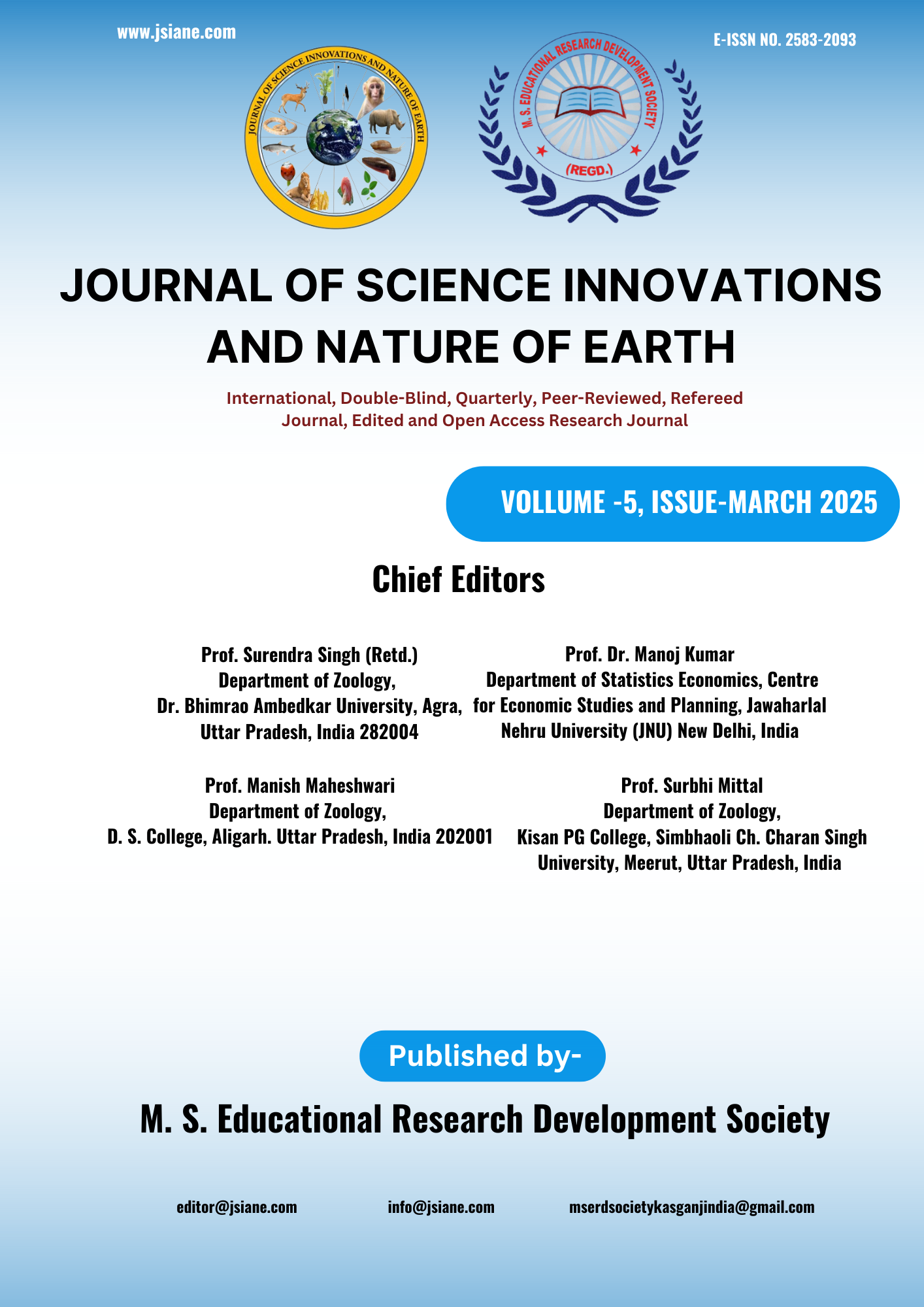Assessment of Behavioural Changes in Wild Drosophila Fed on Normal and High Caloric Diet under Stress of Beta-Cyfluthrin
DOI:
https://doi.org/10.59436/jsiane.338.2583-2093Keywords:
Drosophila, Behaviour, Beta-cyfluthrin, normal and high caloric dietAbstract
Beta-cyfluthrin, a synthetic pyrethroid insecticide, affects the nervous system by altering voltage-gated sodium channels, leading to prolonged neuronal excitation. In Drosophila melanogaster, exposure to beta-cyfluthrin—even at sub-lethal doses—has been shown to induce significant behavioural changes. One prominent effect is impaired locomotion, typically observed through reduced climbing ability, which suggests neuro-muscular dysfunction. Feeding behaviour is also altered; exposed flies often consume less food, potentially due to chemosensory disruption or systemic stress. Reproductive behaviour suffers as well, with both male courtship activity and female receptivity declining after exposure, indicating effects on pheromone signaling and mating motivation. Cognitive functions are impacted, as flies show reduced performance in learning and memory assays, likely due to impaired synaptic transmission in brain regions such as the mushroom bodies. Additionally, treated flies display increased grooming and periods of hyperactivity followed by lethargy—signs consistent with neurotoxic stress. These behavioural disruptions can significantly reduce overall fitness and reproduction, highlighting the ecological risks associated with widespread beta-cyfluthrin use. Drosophila serves as an effective model to evaluate such sub-lethal toxicological impacts, and further studies are warranted to explore long-term effects and underlying molecular mechanisms. The increasing use of synthetic insecticides such as beta-cyfluthrin in agricultural and domestic environments poses significant risks to non-target organisms, including wild insect populations. Among these, Drosophila melanogaster a widely used model organism in behavioural and toxicological studies—offers critical insights into the interaction between diet, environmental toxicants, and neurobehavioural outcomes. This study investigates the behavioural responses of wild Drosophila fed on either a normal diet or a high caloric diet when exposed to sub-lethal concentrations of beta-cyfluthrin, a type II synthetic pyrethroid known for its neurotoxic properties. Wild Drosophila specimens were collected from natural habitats and acclimatized under controlled laboratory conditions. The high caloric diet was formulated by enriching the standard cornmeal-agar medium with additional glucose, simulating energy-dense food sources often found in anthropogenic settings. Beta-cyfluthrin exposure was administered through ingestion by incorporating a sub-lethal concentration into the feeding medium over a 48-hour period.
References
Fournier-Level, A., Perry, E. O., Mignot, C., Matic, I., & Schlötterer, C. (2016). Behavioural response to combined insecticide and temperature stress in natural populations of Drosophila melanogaster. Journal of Evolutionary Biology, 29(4), 766–775.
Creus, A. N. Xamena and R. Marcos (1983). Sensitivity of different strains of Drosophila melanogaster to endosulfan and malathion. Toxicol. Lett., 16 (3-4): 323-330.
Jung, J., Kim, D.-I., Han, G.-Y., & Kwon, H. W. (2018). The Effects of High Fat Diet-Induced Stress on Olfactory Sensitivity, Behaviors, and Transcriptional Profiling in Drosophila melanogaster. International Journal of Molecular Sciences, 19(10), 2855.
Jung, J., Kim, D.-I., Han, G.-Y., & Kwon, H. W. (2018). The Effects of High Fat Diet-Induced Stress on Olfactory Sensitivity, Behaviors, and Transcriptional Profiling in Drosophila melanogaster. International Journal of Molecular Sciences, 19(10), 2855.
Nadda, G., Saxena, P. N., & Srivastava, G. (2005). Effects of sublethal doses of beta-cyfluthrin on mutant Drosophila melanogaster (Diptera: Drosophilidae). Applied Entomology and Zoology, 40(2), 265–271.
Nadda, G., Saxena, P. N., & Srivastava, G. (2005). Effects of beta-cyfluthrin on white and sepia mutants of Drosophila melanogaster. Toxicology International, 12(2), 85–90.
Schultzhaus, J. N., Bennett, C. J., Iftikhar, H., Yew, J. Y., Mallett, J., & Carney, G. E. (2018). High fat diet alters Drosophila melanogaster sexual behavior and traits: decreased attractiveness and changes in pheromone profiles. Scientific Reports, 8, 5387.
Schultzhaus, J. N., Bennett, C. J., Iftikhar, H., Yew, J. Y., Mallett, J., & Carney, G. E. (2018). High fat diet alters Drosophila melanogaster sexual behavior and traits: decreased attractiveness and changes in pheromone profiles. Scientific Reports, 8, 5387.
Palli, S.R. and M. Locke (1988). The synthesis of hemolymph proteins by the larval fat body of an insect Calpodes ethlius (Lepidoptera: Hesperiidae). Insect Biochem., 18:405-413
Saxena, P.N. and G. Srivastava (2002). Evaluation of growth index of Drosophila melanogaster after tributyltin chloride intoxication. Ind. J. Ent., 64 (4).
Strilbytska O. M., T. R. Strutynska, U. V. Semaniuk, N. I. Burdyliuk, K. B. Storey, and O. V. Lushchak, (2021) “Parental dietary sucrose affects metabolic and antioxidant enzyme activities in Drosophila,” Entomological Science, vol. 24, no. 3, pp. 270–280,.
Strilbytska Olha, Tetiana Strutynska, Uliana Semaniuk, Nadia Burdyliyk, Volodymyr Bubalo, Oleh Lushchak, (2022) "Dietary Sucrose Determines Stress Resistance, Oxidative Damages, and Antioxidant Defense System in Drosophila", Scientifica, vol. 2022, Article ID 7262342, 12 pages,. https://doi.org/10.1155/2022/7262342.
Toprak U., D. Hegedus, C. Doğan, G. Güney (2020) A journey into the world of insect lipid metabolism, Arch. Insect Biochem. Physiol., 104 , Article e21682.
Downloads
Published
Issue
Section
License
Copyright (c) 2025 Maharaj Singh Educational Research Development Society

This work is licensed under a Creative Commons Attribution-NonCommercial 4.0 International License.










